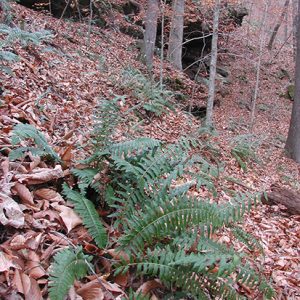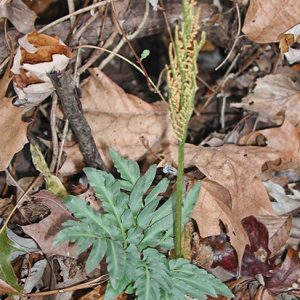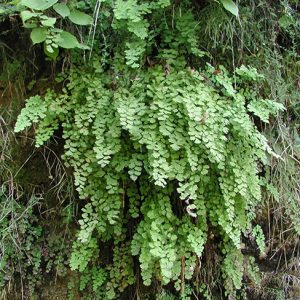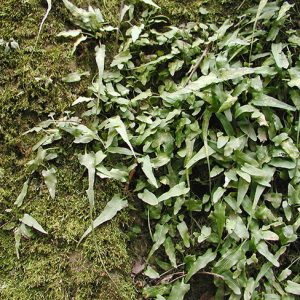calsfoundation@cals.org
Ferns
Ferns are among the most ancient plant forms, distinguished by having a defined vascular system, reproducing by spores, and often having deeply divided leaves that unfurl from a coiled fiddlehead (crozier). They originally appeared in the fossil record about 360 million years ago, but most modern ferns arose in the early Cretaceous period about 145 million years ago. Discussed here are “true” ferns as understood in the horticultural sense and not in the broader classification used by botanists that include horsetails (Equisetum, of which Arkansas has four species), whisk ferns (Psilotum, one species), and sometimes Selaginella (ten species).
Using botanist James H. Peck’s inclusive 2011 list, Arkansas has about eighty species of true ferns that are native to the state, with another twenty-five now established in gardens from the nursery trade. (The focus here will be upon only the native ferns and will be limited to those most likely to be encountered.) Thirteen species are found in all seventy-five Arkansas counties, while another fourteen are found in about half of the counties.
Characteristics of Ferns
The most easily identifiable feature of ferns is their fronds, but the subtleties distinguishing one species from another are often minor and require close examination for correct identification. Ferns may be evergreen or deciduous, and they might have their fronds undivided, pinnately compounded (feather like), or twice or triply pinnately compounded. Most of the more noteworthy species have fronds that average about two feet in length, but some are much smaller.
Spores and spore case (sporangia) architecture are the primary means of fern classification into families, but these are not easily used in field identification. However, identification can be aided by noting the arrangement of the spore cases in structures called sori on the lower surface of the frond, as well as the covering of these sori by a cap called the indusium.
The most common sori arrangement is as a series of brown dots on the undersurface of the pinna. Using sori to differentiate between wood ferns (Dryopteris) and lady fern (Athyrium) may be useful in early summer while they are developing and the indusium has not yet withered away, but, by late summer, the sori of both species just resemble small brown dots.
Ferns may grow as solitary individuals with an upright “trunk,” such as the royal fern (Osmunda regalis var. spectabilis), or in dense clonal colonies via a means of spreading rhizomes, as seen in New York fern (Thelypteris noveboracensis) or bracken fern (Pteridium aquilinum). Usually, ferns spread slowly via an expanding crown that takes years to occupy much space on the ground. Most Arkansas ferns are found in cool, north- or east-facing, moist woodland sites with rich organic soils. But ferns are exploitive and can be found growing on tree trunks, in sunny rock piles, and even in aquatic environments.
Fern taxonomy at the family level is in a state of flux and, while useful for the specialist, is less meaningful to the casual observer. The following list of common Arkansas native ferns puts ferns into broad look-alike groups that may help narrow down choices when seeking to identify an unknown fern.
Ferns with Feather-Like Fronds
Lady fern (Athyrium felix-femina) is found statewide and grows as a twice-pinnate, clump-forming deciduous fern that expands outward, sometimes ending with multiple crowns in a complete or broken circle. Fronds are two to three feet tall with sori centered on the undersurface of the pinna; they exhibit eyelash-shaped indusium if inspected at the right stage of development. Lady fern is found throughout the northern hemisphere with two botanical varieties (var. angustatum, northern; var. aspenioides, southern) described in the eastern states. In Arkansas, both varieties are found, sometimes mixed in the same stand, where they occur in moist woods and swampy land. This species and its many clones are common in cultivation.
The wood ferns (Dryopteris) are well represented in Arkansas, where eight species and/or hybrids are described. Generally, they are more common in northern states, with Arkansas at the southern end of their distribution. They range from the northeastern corner of the state to the southwestern corner and are less commonly encountered in the Delta region. They have brown, wooly stalks that, when cut transversely, show five vascular bundles, each encased in a black sheath.
Marginal wood fern (Dryopteris marginalis) is an evergreen species typically found on wooded slopes at the forest margin, often growing in cracks in large sandstone outcrops. Twice-pinnate fronds are eighteen to twenty-four inches long with sori produced at the margins of the pinnules, making this species among the easiest to identify. While technically evergreen, the fronds tend to sprawl across the ground during the winter months. This species is easy to grow in gardens and is widely available.
Narrow-leaved glade fern (Diplazium pycnocarpon) occurs widely in the eastern states and in Arkansas throughout the Ozark Mountains, where it grows in moist woodlands in neutral soils. It has deciduous pinnate dimorphic (two-type) fronds with the sterile fronds two feet or more in length and arching, while the late summer fertile fronds are narrower and held stiffly erect.
Christmas fern (Polystichum acrostichoides) is probably the most often seen native fern in Arkansas because it is evergreen and occurs statewide, showing up readily in the wintertime landscape against the brown leaves on the forest floor. It is a clump-forming, solitary, thick-leaved evergreen species with pinnate dark-green fronds eighteen to twenty-four inches long. Sori are produced on the terminal third of the frond, causing these pinnae to be much reduced in size. It occurs in open woodlands, on slopes, and along forested roadways in fertile soils. It seldom is seen in dense stands in the wild but, as a landscape subject, can be grown as a groundcover. In early spring, old fronds collapse and are replaced by new, unfurling fronds.
New York fern (Thelypteris noveboracensis) is one of three species of maiden ferns scattered across the Arkansas uplands where, collectively, they can be found in about half of the state’s counties. It is a fast-growing deciduous rhizomatous fern that produces twice-pinnate fronds one to two feet tall. This and other Thelypteris are covered with fine, needle-like hairs that are white or translucent and easily seen with a hand lens. It typically occurs in moist bottomlands along streams and shaded roadside ditches. When cut in cross section, the main shaft shows two whitish, pollywog-shaped vascular bundles.
Three widely distributed ferns have fronds with the pinnae attached to the midrib by means of a broad wing. First, broad beech fern (Phegopteris hexagonoptera) occurs statewide, with the exception of a few counties adjacent to the Mississippi River. It is a twice-pinnate deciduous rhizomatous fern growing two feet tall with a broad, triangular frond up to a foot wide. The pinnae are attached to the midrib by means of a broad wing, with the round sori sparsely scattered on the lower surface. It grows in moist woodlands and along the edges of ponds and lakes. Because of its wide-ranging rhizomes, it is seldom grown in gardens. Second, sensitive fern (Onoclea sensibilis) grows to a foot tall with fronds arising from a broad-spreading rhizome. Fronds are blunt and less feathery than broad beech fern, with spores produced on an erect sterile frond. Often found growing in wet, swampy areas or along streams, sensitive fern gets its name from its tendency to quickly wither away when touched by drought or frost. Third, the netted chain fern (Woodwardia areolata) is a deciduous creeping fern with winged midveins that reach sixteen inches long. Its fronds are dimorphic, with the fertile fronds narrower and producing spores down the center of the pinnae in a continuous band. It occurs statewide and is found in moist seeps.
Two widely distributed ferns with feathery fronds that are smaller in stature than those listed above are the cliff break fern (Woodsia obtuse) and fragile fern (Cystopteris sp.). Both have nearly statewide distribution. Woodsia has twice-pinnate evergreen fronds less than a foot long that lie flat on the rocky ledges where it typically grows during the winter. The spores are produced in cup-shaped indusia that are divided into four segments. Fragile fern is twice and three times pinnate and begins growing early during the late winter.
The last two common ferns with feather-like fronds are usually seen growing on rocks or in crevices or on shaded tree trunks. First, the rock polypody (Polypodium virginianum) is a shallowly rhizomatous evergreen species found growing in the Ozark region in crevices. The once-pinnate fronds are less than a foot long, with the segments cut almost to the midrib of each frond. Second, resurrection fern (Pleopeltis polypodioides) occurs statewide and is found growing as an epiphyte on rock surfaces and tree trunks. It is so named because its leathery, six-inch-long evergreen fronds expand during wet weather and then roll up and turn brown during dry conditions. The two species have a similar appearance when fully hydrated, but resurrection fern is only half as large and rock polypody.
Maidenhair Fern Relatives
Maidenhair ferns and their close relatives are easily recognized and characterized by having spores produced on the outer edges of the pinnae, with the edge covering them in a kind of flap. Three genera in this group are common in Arkansas. Ferns in this group extend north from warmer tropical climes, whereas most of the species listed above extend south from colder climates.
Two maidenhair ferns (Adiantum pedatum, northern maidenhair or five-finger fern, and A. capillus-veneris, southern maidenhair) occur in Arkansas, with the former found primarily in the Ozarks, while the latter occurs statewide except in the Gulf Coastal Plain. The northern maidenhair is found in moist, fertile, well-drained land on north-facing slopes. It is deciduous and produces a slender purple-black stem that forks terminally to produce two arms that usually bear five fingers of pinnae along one side of the branch. Plants reach sixteen inches tall and spread via a moderately vigorous rhizome. Southern maidenhair fern is a cosmopolitan species that occurs in warmer areas throughout the world. It is deciduous and grows to about eight inches tall with wiry, purple-black stems and delicate, triangular pinna. When found in the wild, it is usually growing on rocks and associated with a protected cliff that has a spring or free-flowing water nearby. Large mats of vegetation can form. Plants are hardy down to about 0º F.
Purple cliffbreak (Pellaea atropurpurea) is a smallish evergreen clumping fern with fronds eight to sixteen inches long. It has reddish-purple stems and mostly twice-pinnate fronds. Spore-producing pinnae are narrower, with spores produced in a line under the margin of the leaf. This species is found in mountainous parts of the state and is the most widely distributed of the genus, as it ranges from New York to Arizona.
Hairy lipped ferns (Cheilanthes lanosa; C. tomentosa) are two of the five species of Cheilanthes occurring in Arkansas. These are small creeping ferns with evergreen leaves that grow in limestone or sandstone crevices or on rocky shelves. Fronds are usually less than six inches long, twice or three times pinnate, with spores produced on the outer edge of the pinnae. They are extremely drought tolerant and can grow in full sun or in the shade, but not in moist shade like most ferns. They occur in the mountainous regions of the state.
Osmunda Ferns
Osmunda ferns are among the ancient classes of ferns with worldwide distribution. In Arkansas, two species are found statewide. Cinnamon fern (Osmundastrum cinanamomea), thought to be the oldest extant fern in the world, has been moved to its own genera but is still considered with the other Osmunda ferns. It has deciduous, once-pinnate erect fronds two to four feet long arising from a creeping rhizome from strong crowns. In rich, moist, shaded sites, it can colonize an extended area. Sori are produced on erect, cinnamon-colored, specialized fronds that appear in midsummer. The other species, royal fern (O. regalis var. spectabilis), is an erect-growing deciduous fern with fronds three to four feet tall arising from a blackish trunk that may be several inches long. Fronds are twice-pinnate, gray-green, and somewhat waxy. Spores are produced at the ends of some fronds and look like a shriveled mistake of nature. This species grows in boggy sites or even in running water.
Other Ferns
The spleenworts are a widely distributed group of small ferns with worldwide distribution. Though they are all in the same genus, they can appear quite different from each other. Nine species are known to occur in Arkansas, with the black-stemmed ebony spleenwort (Asplenium platyneuron) as the most common. Walking spleenwort (A. rhizophyllum) occurs on rocks in cool, moist Ozark valleys, where it produces a long, slender, whip-like frond that grows a new plantlet at the tip and literally walks across the surface of the rock.
Grape fern (Botrychium biternatum and B. dissectum) occurs statewide and is found in fertile woodland sites where it has one three-pinnate frond and one sterile, spore-producing frond. Plants reach fourteen inches tall and are evergreen during winter but disappear during the summer. Five species of the related adder’s tongue fern (Ophioglossum sp.) are described in the state and, between them, cover most of the state. They, like the grape ferns, are an ancient evolutionary class of ferns and have a single, tongue-shaped, un-dissected frond that emerges from the base with spores produced on the end.
For additional information:
Peck, James H. “History of Arkansas Pteridophyte Studies with a New Annotated Checklist and Floristic Analysis.” Phytoneuron (2011) 1–39. Online at http://www.phytoneuron.net/PhytoN-Arkansasfernfloristics.pdf (accessed September 13, 2021).
———. “New and Noteworthy Additions to the Arkansas Fern Flora.” Phytoneuron (2011): 1–33. Online at http://www.phytoneuron.net/PhytoN-Arkansasferns.pdf (accessed September 13, 2021).
Peck, James H., and W. Carl Taylor. “Checklist and Distribution of Arkansas Pteridophytes.” Proceedings of the Arkansas Academy of Science 49 (1995): 130–137. Online at http://libinfo.uark.edu/aas/issues/1995v49/v49a27.pdf (accessed September 13, 2021).
Gerald Klingaman
Botanical Garden of the Ozarks
 Science and Technology
Science and Technology Christmas Fern
Christmas Fern  Grape Fern
Grape Fern  Marginal Shield Fern
Marginal Shield Fern  Royal Fern
Royal Fern  Southern Maidenhair Fern
Southern Maidenhair Fern  Walking Fern
Walking Fern 




Comments
No comments on this entry yet.